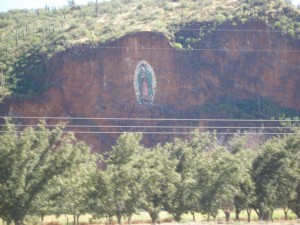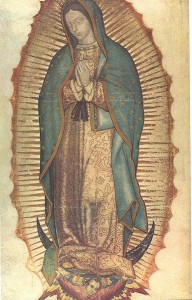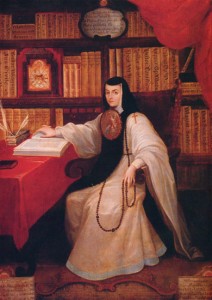The Virgin Mary is everywhere in the area I live.

The Virgin of Guadalupe painted on a hillside along a major highway between Magdalena and Santa Ana, Sonora, Mexico
I was raised Roman Catholic. I like the ritual of the religion and the strong foundations it has to my ancestry in Poland, Germany, and France. I share the very core beliefs of the religion, like the changing of the wine and bread into the Eucharist.
I have lived in the Southwestern United States for six years. Catholicism is different here than in other places I’ve called home. This is because of the religious iconography associated with the Catholic practices of Mexico. The town and surrounding environs are filled with Mexican-influenced imagery. I assume part of that emerges from the belief the Virgin Mary appeared near Mexico City in the year 1531.
This is the “Our Lady of Guadalupe.”  I would even say, although I have no evidence to support this, that Our Lady of Guadalupe is Mexico’s most popular religious and cultural image. That’s the Virgin Mary I see everywhere.
I would even say, although I have no evidence to support this, that Our Lady of Guadalupe is Mexico’s most popular religious and cultural image. That’s the Virgin Mary I see everywhere.
I read some poetry by a scholar and nun who lived in Mexico during the late 1600s. My reading interests are unique for sure. It’s almost as though Juana Ines de la Cruz was influenced by the Virgin’s appearance, although she obviously didn’t witness it herself. Her poems are filled with imagery reminding me of the picture to the left. Mary is being lifted by a person (an angel?) at the bottom of the artwork. See it?
de la Cruz writes “who nestling in the fragrant fires/ of sweet gums and perfumes/ reanimates herself just when/ she seems to be consumed” (p. 174). The words make me think of Our Lady of Guadalupe as a Phoenix. And I like the idea of a woman rising from pain or fear into a world of hope. Just when things seem to be at an end, she pulls herself up and over the fire.
So, not only have I been inspired by the Lady of Guadalupe imagery, I’ve had the chance to discover and learn more about Sister Juana. de la Cruz was strong enough to pursue education and knowledge despite the Church censuring this behavior. She was a voracious learner during a time when it wasn’t cool for women to be seeking education. She was a rebellious nun.
Of course, in great martyr-like fashion she did die after helping other nuns who were sick during a plague.
But most importantly, in life and death, she and the Virgin Mary were both strong.


Losing focus Sip and Go Girl?